China’s Rural Industrial Integration Under the “Triple Synergy of Production, Livelihood and Ecology” Philosophy: Internal Mechanisms, Level Measurement, and Sustainable Development Paths
Abstract
1. Introduction
2. Literature Review
2.1. The “Triple Synergy of Production, Livelihood and Ecology” Philosophy
2.2. Rural Industrial Integration
- Stage I (pre-2015): Early definitions approached integration from three complementary angles. First, focusing on outcomes, rural industrial integration was understood as the blending of agricultural technologies, products, services, and markets with other sectors, thereby creating new value propositions and novel business models [19]. Second, emphasizing process, rural industrial integration was characterized as the reconfiguration of agricultural and non-agricultural goods or services to form an integrated whole under a unified set of standards [20]. Third, adopting a synthesis view, the phenomenon of rural industrial integration was framed as a resource-optimizing, innovation-driven reorganization of micro-level actors across sectoral boundaries, ultimately yielding a new agricultural form distinguished by its hybrid industrial attributes [21].
- Stage II (post-2015): Since China’s No. 1 central document for 2015 formally proposed the notion of “integration of the primary, secondary, and tertiary industries in rural areas”, Chinese scholars have adopted a more holistic stance, integrating analyses of modalities, pathways, drivers, and outcomes of convergence. Representative perspectives are summarized in Table 1.
3. Adaptability and Mechanism: Rural Industrial Integration and the “Triple Synergy of Production, Livelihood and Ecology” Philosophy
3.1. Adaptability
3.1.1. Congruent Development Core
3.1.2. Mutual Implementation Vehicles
3.2. Mechanisms
3.2.1. Rural Production Activities and Industrial Integration
3.2.2. Rural Livelihood and Industrial Integration
3.2.3. Rural Ecological Environment and Industrial Integration
4. Evaluation of China’s Rural Industrial Integration Levels
4.1. Evaluation Index System Construction Based on LDA Topic Model
4.1.1. Text Acquisition and Pre-Processing
4.1.2. LDA Topic Extraction
- Identifying the Optimal Number of Topics
- 2.
- Topic Clustering and Keyword Frequency Analysis
- 3.
- Evaluation Index System Construction
- The GDP of the primary sector measures the aggregate scale of primary-industry activity and directly reflects the agricultural dimension of integration;
- The rural employment situation counts rural workers;
- Per capita disposable income of rural residents is the most immediate standard measurement of integration success;
- Central government fiscal expenditure on agriculture, forestry and water affairs describes state funds channeled into rural development, which boosts farm incomes and reveals latent consumption growth;
- The total power of agricultural machinery—the sum of rated power of all farm machines—marks the pace of agricultural mechanization and uptake of advanced equipment;
- The agro-processing industry output (operating revenue of processing enterprises) captures value addition and the depth of agriculture–secondary-industry integration;
- New-product projects in above-scale agro-processing enterprises reflect technology spill-overs from integrated production;
- Rural retail sales measure turnover of consumer goods in rural retail outlets and mirrors local market vitality;
- Rural household investment in services (fixed-asset investment in wholesale, retail, transport, storage, and postal services) indicates commitment to rural special industries and the breadth of agriculture–service integration;
- Rural household investment in accommodation and catering underpins visitor infrastructure and diversification into agritourism; it is a direct proxy for farmer-level capital allocation to leisure agriculture;
- The rural entrepreneurship activity index—defined as the ratio of rural private-enterprise plus self-employed workers to the total rural population—infuses integration with new dynamism;
- The number of rural cooperatives signals cooperative intensity in production, fosters scaled and intensive management, and improves benefit-sharing among farmers.
- The operating revenue of leisure agriculture captures income generated by leisure-oriented activities and provides evidence for primary–tertiary sector convergence.
- Share of rural population records the proportion of rural residents in the total population;
- The number of senior-secondary graduates in rural areas reflects rising educational levels in rural areas and provides a cohort of knowledgeable, skilled workers for integration, underscoring human-capital gains within the process;
- Length of rural postal delivery routes measures the total length of delivery networks in rural areas and serves as a proxy for digital-logistics infrastructure.
- The amount of rural broadband subscribers gauges the penetration of high-speed internet and underpins the digital layer of rural industrial integration;
- Agricultural insurance coverage provides risk protection, strengthens farmers’ resilience to natural disasters and market shocks, and safeguards the continuity of agricultural production, reflecting the maturity of rural social services;
- Fiscal expenditure for consolidating poverty-alleviation achievements and advancing rural revitalization captures central transfers earmarked for the transition from poverty eradication to rural revitalization;
- The number of rural residents receiving minimum living allowances records the number of beneficiaries under rural subsistence schemes.
- Chemical fertilizer application, pesticide use and agricultural plastic film use quantify anthropogenic inputs to farmland; while moderate use can raise short-term yields, excessive application degrades soil health and surrounding ecosystems, thereby contravening long-term sustainability objectives;
- Soil-erosion control area and water-saving irrigation area measure physical interventions that conserve soil and water, directly evidencing environmental stewardship within the integration process;
- National afforestation area reflects large-scale ecological restoration efforts and the expansion of rural green infrastructure;
- The number of solar water heaters in rural areas reflects the uptake of renewable and efficient energy technologies, signaling a shift toward low-carbon rural production and consumption patterns.
4.2. Measuring the Level of Rural Industrial Integration Based on the Entropy Method
4.2.1. Entropy Method
- Dimensionless processing
- Translation of the normalized data:
- Compute the entropy:
- Calculate the coefficient of variation:
- Calculate the weight:
- Compute the composite index of rural industrial integration:
4.2.2. Results and Discussion
- Indicator Weights for Rural Industrial Integration
- Rural household investment in accommodation and catering;
- Length of rural postal delivery routes;
- Chemical fertilizer application;
- Pesticide use;
- Agricultural insurance coverage;
- New-product projects in above-scale agro-processing enterprises.
- Production activities
- Livelihood standards
- Ecology level
- 2.
- Annual Evaluation Index Results of China’s Rural Industrial Integration
- Production
- Livelihood
- Ecology
5. Sustainable Development Paths for Rural Industrial Integration
5.1. Methods
- Multifactor complexity
- Feedback-driven uncertainty
- Long-run dynamic analysis
5.2. System Dynamics Model Construction for Rural Industrial Integration
5.2.1. Subsystem and Causal Loop Diagram
- Rural Production Subsystem
- 2.
- Rual Livelihood Subsystem
- 3.
- Rural Ecological Subsystem
5.2.2. Construction of the Stock-And-Flow Diagram and Specification of Model Equations
5.2.3. Model Validity Assessment
5.3. Development Pathways for Rural Industrial Integration
5.3.1. Scenario Simulation of Development Pathways and Parameter Configurations
- Scenario 1: Green Ecological Development Priority Pathway
- Scenario 2: Livelihood Standard Development Priority Pathway
- Scenario 3: Production Level Development Priority Pathway
5.3.2. Scenario Forecasting Results
5.3.3. Forecasting Results Analysis
6. Discussion
7. Conclusions
Author Contributions
Funding
Institutional Review Board Statement
Informed Consent Statement
Data Availability Statement
Conflicts of Interest
Appendix A

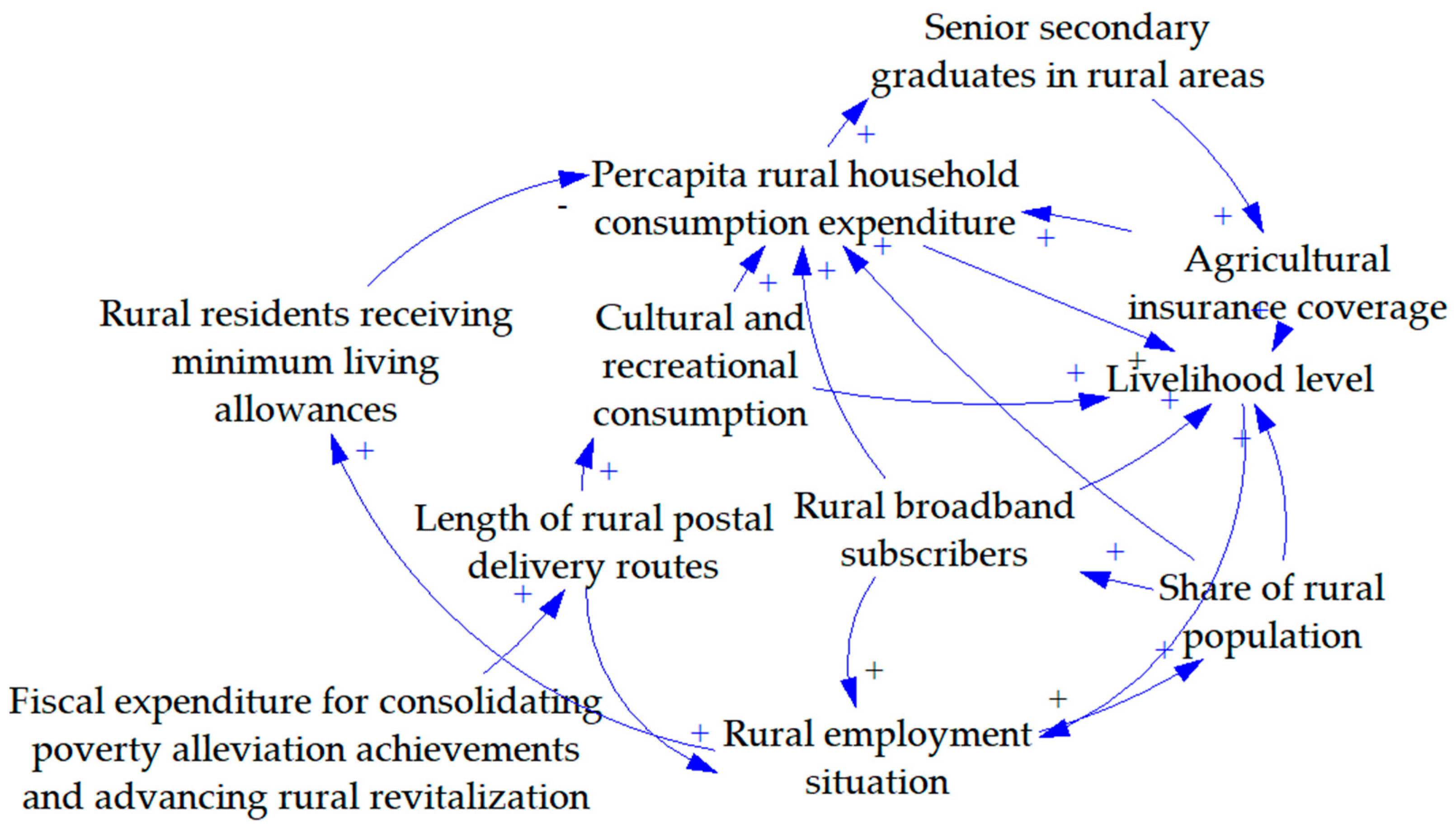
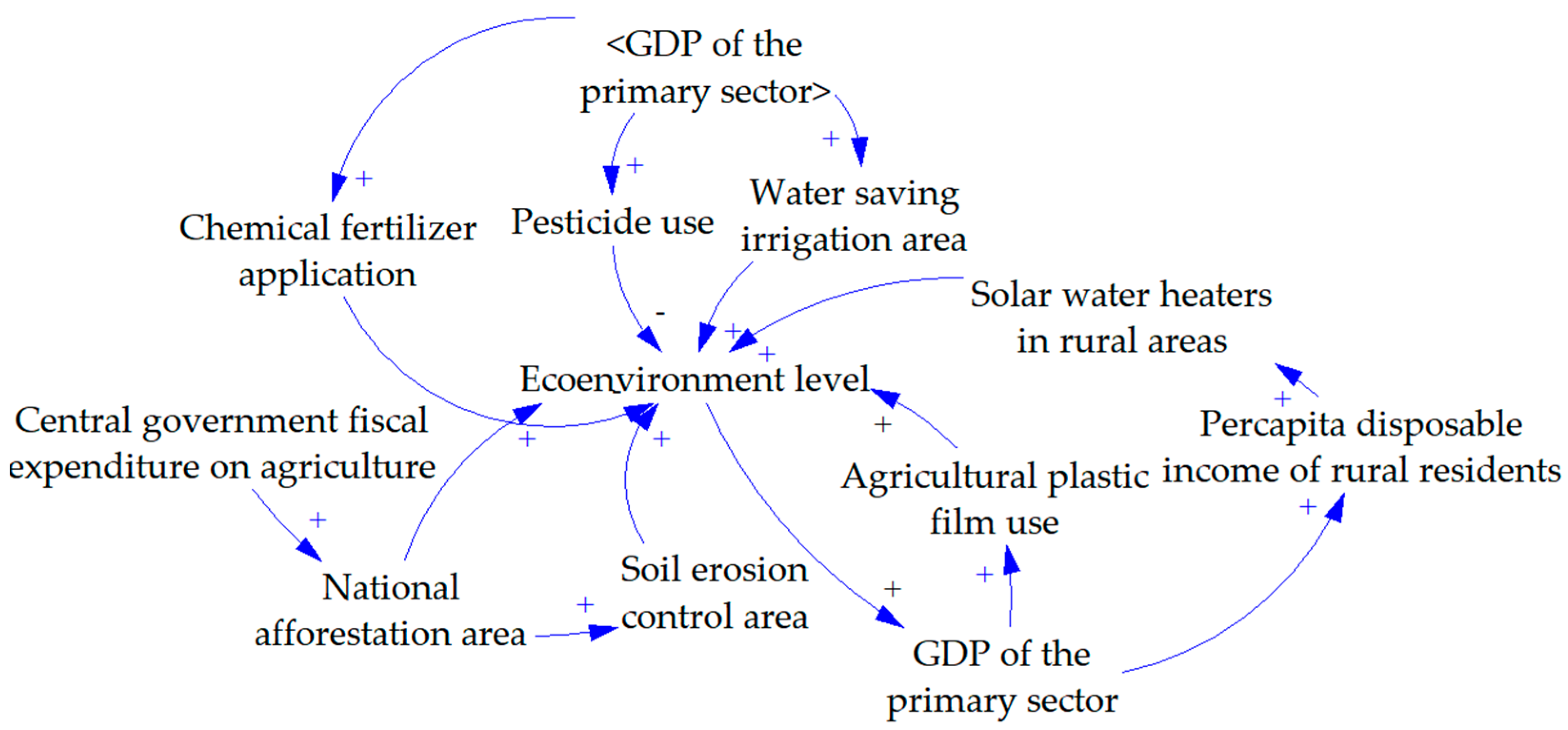
Appendix B
- Incremental change in livelihood level = INTEG (0.030199 × share of rural population + 0.026891 × per capita rural household consumption expenditure + 0.029496 × cultural and recreational consumption + 0.0538 × senior-secondary graduates in rural areas + 0.037409 × agricultural insurance coverage + 0.048617 × rural broadband subscribers);
- Incremental change in ecology level = INTEG (−0.030578 × chemical fertilizer application + 0.038682 × national afforestation area + 0.038213 × solar water heaters in rural areas − 0.05071 × agricultural plastic film use − 0.018457 × pesticide use + 0.022509 × soil-erosion control area + 0.021776 × water-saving irrigation area);
- GDP of the primary sector = INTEG (incremental change in GDP of the primary sector + 0.02 × rural industrial integration level);
- Incremental change in GDP of the primary sector = INTEG (GDP for the primary sector × growth rate of GDP of the primary sector + 0.0013 × rural retail sales + 0.0053 × rural household investment in accommodation and catering + 0.0017 × agro-processing industry operating revenue + 0.0058 × new-product projects in above-scale agro-processing enterprises);
- Rural industrial integration development level = INTEG (0.3 × production development level + 0.5 × ecology level + 0.2 × livelihood level − 0.5 × rural industrial integration development level);
- Rural household investment in services = INTEG (0.04523 × agro-processing industry operating revenue + 0.0374 × central government fiscal expenditure on agriculture, forestry, and water affairs).
Appendix C
| Variables | Year | True Value | Predicted Value | Error |
|---|---|---|---|---|
| GDP of the primary sector | 2013 | 53,028 | 54,044 | 1.92% |
| 2014 | 55,626 | 56,372 | 1.34% | |
| 2015 | 57,775 | 59,978 | 3.81% | |
| 2016 | 60,139 | 62,106 | 3.27% | |
| 2017 | 62,100 | 62,887 | 1.27% | |
| 2018 | 64,745 | 66,705 | 3.03% | |
| 2019 | 70,474 | 71,643 | 1.66% | |
| 2020 | 78,031 | 78,812 | 1.00% | |
| 2021 | 83,217 | 84,811 | 1.92% | |
| 2022 | 88,345 | 88,761 | 0.47% | |
| Per capita disposable income of rural residents | 2013 | 9430 | 9496 | 0.70% |
| 2014 | 10,489 | 10,695 | 1.96% | |
| 2015 | 11,422 | 11,785 | 3.18% | |
| 2016 | 12,363 | 12,949 | 4.74% | |
| 2017 | 13,432 | 13,992 | 4.17% | |
| 2018 | 14,617 | 15,000 | 2.62% | |
| 2019 | 16,021 | 16,795 | 4.83% | |
| 2020 | 17,132 | 17,338 | 1.20% | |
| 2021 | 18,931 | 19,822 | 4.71% | |
| 2022 | 20,133 | 20,448 | 1.57% | |
| Per capita rural household consumption expenditure | 2013 | 7485 | 7791 | 4.09% |
| 2014 | 8383 | 8499 | 1.38% | |
| 2015 | 9223 | 9306 | 0.90% | |
| 2016 | 10,130 | 10,487 | 3.52% | |
| 2017 | 10,955 | 11,348 | 3.59% | |
| 2018 | 12,124 | 12,451 | 2.69% | |
| 2019 | 13,328 | 13,745 | 3.13% | |
| 2020 | 13,713 | 14,023 | 2.25% | |
| 2021 | 15,916 | 16,203 | 1.80% | |
| 2022 | 16,632 | 17,331 | 4.20% | |
| Senior-secondary graduates in rural areas | 2013 | 26.00 | 27 | 3.25% |
| 2014 | 25.20 | 26 | 4.70% | |
| 2015 | 24.70 | 26 | 3.42% | |
| 2016 | 23.30 | 24 | 4.60% | |
| 2017 | 23.10 | 24 | 4.61% | |
| 2018 | 24.10 | 24 | 0.50% | |
| 2019 | 24.90 | 26 | 3.55% | |
| 2020 | 24.90 | 25 | 0.30% | |
| 2021 | 24.80 | 25 | 1.84% | |
| 2022 | 27.50 | 28 | 0.52% | |
| New-product projects in above-scale agro-processing enterprises | 2013 | 6816 | 7032.14 | 3.17% |
| 2014 | 7594 | 7695.67 | 1.34% | |
| 2015 | 7295 | 7396.15 | 1.39% | |
| 2016 | 9649 | 9771.79 | 1.27% | |
| 2017 | 11,323 | 11,490.51 | 1.48% | |
| 2018 | 11,862 | 11,893.25 | 0.26% | |
| 2019 | 13,771 | 13,806.00 | 0.25% | |
| 2020 | 16,658 | 17,427.79 | 4.62% | |
| 2021 | 19,658 | 19,664.12 | 0.03% | |
| 2022 | 22,528 | 23,100.89 | 2.54% | |
| Rural household investment in accommodation and catering | 2013 | 29.9 | 30.80 | 3.03% |
| 2014 | 41.3 | 42.03 | 1.77% | |
| 2015 | 42.4 | 42.92 | 1.23% | |
| 2016 | 28.9 | 30.18 | 4.42% | |
| 2017 | 38.3 | 39.12 | 2.14% | |
| 2018 | 119.4 | 124.75 | 4.48% | |
| 2019 | 71.7 | 73.11 | 1.97% | |
| 2020 | 35.3 | 35.32 | 0.05% | |
| 2021 | 68.1 | 70.41 | 3.40% | |
| 2022 | 37.1 | 37.36 | 0.69% | |
| Length of rural postal delivery routes | 2013 | 3,744,733 | 3,806,541.34 | 1.65% |
| 2014 | 3,775,875 | 3,912,093.76 | 3.61% | |
| 2015 | 3,756,043 | 3,777,766.63 | 0.58% | |
| 2016 | 3,767,660 | 3,847,005.22 | 2.11% | |
| 2017 | 3,805,332 | 3,985,117.80 | 4.72% | |
| 2018 | 4,030,582 | 4,074,393.76 | 1.09% | |
| 2019 | 4,198,813 | 4,209,943.73 | 0.27% | |
| 2020 | 4,104,128 | 4,264,459.93 | 3.91% | |
| 2021 | 4,155,496 | 4,354,446.78 | 4.79% | |
| 2022 | 4,146,853 | 4,198,283.54 | 1.24% | |
| Agricultural insurance coverage | 2013 | 306.59 | 321.32 | 4.80% |
| 2014 | 325.78 | 334.09 | 2.55% | |
| 2015 | 374.90 | 385.38 | 2.80% | |
| 2016 | 417.71 | 423.67 | 1.43% | |
| 2017 | 478.90 | 482.36 | 0.72% | |
| 2018 | 572.74 | 572.91 | 0.03% | |
| 2019 | 672.48 | 680.15 | 1.14% | |
| 2020 | 814.93 | 818.69 | 0.46% | |
| 2021 | 975.80 | 992.70 | 1.73% | |
| 2022 | 1219.30 | 1238.13 | 1.54% | |
| Chemical fertilizer application | 2013 | 5911.9 | 6039.66 | 2.16% |
| 2014 | 5995.9 | 6257.88 | 4.37% | |
| 2015 | 6022.6 | 6314.24 | 4.84% | |
| 2016 | 5984.4 | 5992.81 | 0.14% | |
| 2017 | 5859.4 | 5953.91 | 1.61% | |
| 2018 | 5653.4 | 5923.18 | 4.77% | |
| 2019 | 5403.6 | 5659.01 | 4.73% | |
| 2020 | 5250.7 | 5483.05 | 4.43% | |
| 2021 | 5191.3 | 5273.50 | 1.58% | |
| 2022 | 5079.2 | 5191.48 | 2.21% | |
| Pesticide use | 2013 | 180.2 | 182.20 | 1.11% |
| 2014 | 180.7 | 186.37 | 3.14% | |
| 2015 | 178.3 | 183.23 | 2.77% | |
| 2016 | 174 | 177.22 | 1.85% | |
| 2017 | 165.5 | 170.41 | 2.97% | |
| 2018 | 150.36 | 157.84 | 4.97% | |
| 2019 | 145.6 | 151.37 | 3.96% | |
| 2020 | 131.3 | 133.07 | 1.35% | |
| 2021 | 123.9 | 129.34 | 4.39% | |
| 2022 | 119 | 121.46 | 2.07% |
Appendix D
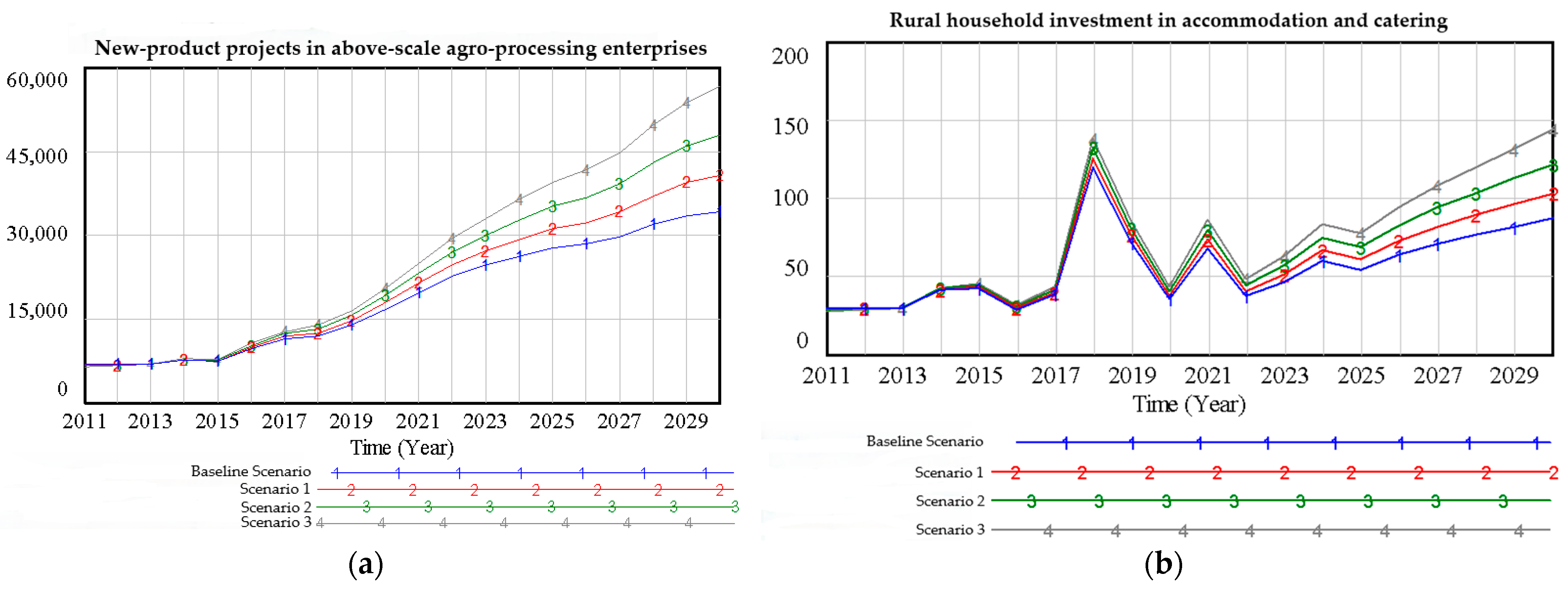
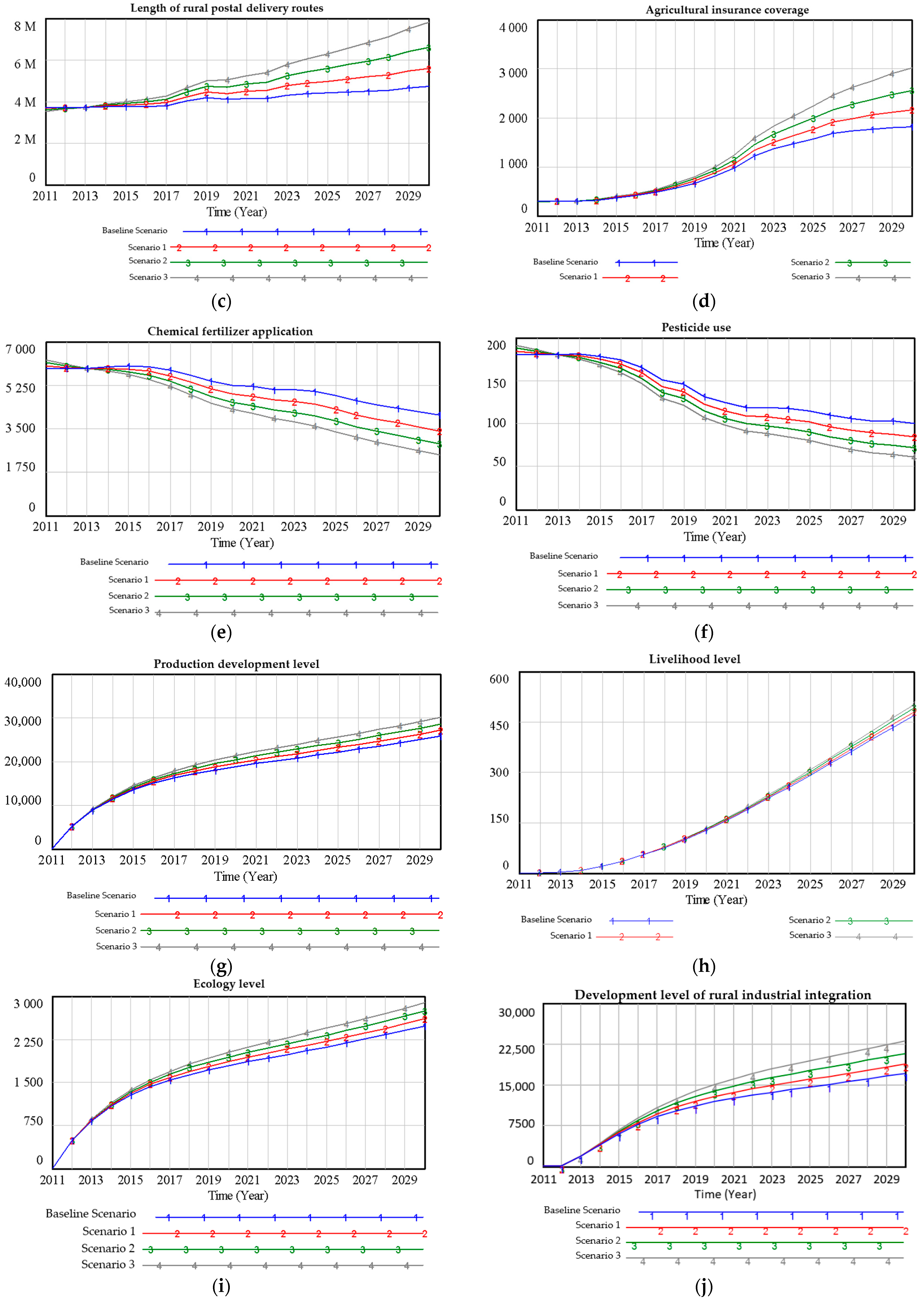
References
- Mihai, F.-C. Circular Economy and Sustainable Rural Development. Sustainability 2023, 15, 2139. [Google Scholar] [CrossRef]
- Zhou, G.; Long, H.; Lin, W.; Qiao, J.; Tan, H.; Yang, K.; Yue, W.; Yun, W.; Huang, X.; Lu, H.; et al. Theoretical Debates and Practical Development of the “Three Rural Issues” and Rural Revitalization in the New Era. J. Nat. Resour. 2023, 38, 1919–1940. [Google Scholar] [CrossRef]
- Cai, M.; Shi, M. Discussion on the Path of Coordinated Development of Regional Economy under the Background of Rural Revitalization. Int. J. Front. Sociol. 2023, 5, 28–33. [Google Scholar] [CrossRef]
- Wang, S. Planning and Management of Tourist Agricultural Parks; China Social Sciences Press: Beijing, China, 2007. [Google Scholar]
- Wu, Q.; Feng, J.; Chen, G.; Chen, T. The Spatial Evolution and Optimization of Production—Living—Ecology Space Inmountainous Rural Tourism Destinations: A Case Study of Jinlin Watery Area inDeqing County, Guangdong Province. Acta Ecol. Sin. 2020, 40, 5560–5570. [Google Scholar]
- Zhu, L. Connotations, Challenges and Strategic Ideas for the Sustainable Development of China’s Agriculture. Theor. Investig. 2014, 73–76. [Google Scholar] [CrossRef]
- Wang, C.; Tang, N. Spatio-Temporal Characteristics and Evolution of Rural Production-Living-Ecological Space Function Coupling Coordinationin Chongqing Municipality. Geogr. Res. 2018, 37, 1100–1114. [Google Scholar]
- Zhou, J. Macro Control Mechanism of Urban-Rural Layout with Three Lines, Three Spaces, and Three Controls. Planners 2019, 5–12. [Google Scholar]
- Liu, Y.; Ren, Y.; Pan, Y.; Tang, L. Rural Development Pattern and Zoning for Rural Revitalization Strategy. Trans. Chin. Soc. Agric. Eng. 2019, 35, 281–289. [Google Scholar]
- Cao, G.; Gu, C.; Zhang, Q. Recognition of “Ecological Space, Living Space, and Production Space” in the Urban Central Area Based on POI Data: The Case of Shanghai. Urban Plan. Forum 2019, 2, 44–53. [Google Scholar]
- Liu, P.; Wang, Y.; Huang, Y.; Luo, X.; Gao, C.; Weng, B. Development of a “Production-Ecology-Life” Coupling Tea Garden in a Mountain Area. Chin. J. Eco-Agric. 2019, 27, 785–792. [Google Scholar]
- Ma, X.; Li, X.; Hu, R.; Khuong, M.H. Delineation of “Production-Living-Ecological” Space for Urban Fringe Based on Rural Multifunction Evaluation. Prog. Geogr. 2019, 38, 1382–1392. [Google Scholar] [CrossRef]
- Zhou, H.; Jin, P.; Xia, W. Functional Zoning of Territorial Space in Provincial Level Based on the Production-Living-Ecological Functions: A Case of Henan Province. China Land Sci. 2020, 34, 10–17. [Google Scholar]
- Zhou, Y.; Zhou, G.; Huang, Q.; Yue, L. A Study on Distribution of Production, Living and Ecological Spaces in Karst Areas Based on Lorenz Curves and Land Use Transitions. Bull. Soil Water Conserv. 2020, 40, 297–304+325. [Google Scholar]
- Huang, J.; Xue, D.; Dong, C.; Wang, C.; Zhang, C.; Ma, B.; Song, Y. Eco-Environmental Effects and Spatial Differentiation Mechanism of Land Use Transition in Agricultural Areas of Arid Oasis: A Perspective Based on the Dominant Function of Production-Living-Ecological Spaces. Prog. Geogr. 2022, 41, 2044–2060. [Google Scholar] [CrossRef]
- Liu, H.; Li, Q.; Di, W.; Lu, J.; Yu, L. Land-Use Transformation of Production-Living-Ecology Space along Yellow River in Henan Province: Eco-Environment Effect and Driving Factors. Environ. Sci. Technol. 2024, 47, 186–189. [Google Scholar]
- Zeng, Y.; Su, X.; Wang, M.; Wen, C. Eco-Environmental Effects and Spatial Differentiation Mechanism of Transformation of Productional-Living-Ecological Space in Upper Reaches of Yangtze River. Bull. Soil Water Conserv. 2024, 44, 284–295. [Google Scholar]
- Gui, J.; Guo, G.; Zhang, H. Spatial Characteristics of Production-Living-Ecological Geographical Space of a Typical City in the Lower Yellow River Plain Area. Yellow Rive 2022, 44, 105–110. [Google Scholar]
- Sun, Z. Path Transformation in Agricultural Industrialization: Industrial Convergence and Industrial Clustering. Econ. Surv. 2005, 37–39. [Google Scholar] [CrossRef]
- Wang, X. Industry Convergence——New Concept of Agriculture Industrilization. Res. Agric. Mod. 2007, 28, 303–306+321. [Google Scholar]
- Jiang, C. Thoughts on Developing Agricultural Productive Service Industry. Issues Agric. Econ. 2016, 37, 8–15+110. [Google Scholar]
- Jiang, C. The Paths and Key Points of Promoting Industrial Integrated Development among Primary, Secondary and Tertiary Industries in Rural China. Acad. J. Zhongzhou 2016, 5, 43–49. [Google Scholar]
- Zhao, X.; Han, Y.; Jiang, N. Integration of Three Industries in Rural Areas: Connotation Definition, Realistic Meanings and Driving Factors Analysis. Issues Agric. Econ. 2017, 38, 49–57+111. [Google Scholar]
- Chen, J.; Chen, C.; Chen, M. Several Reflections on the Integrated Development of Primary, Secondary and Tertiary Industries in Rural China. Agric. Econ. 2017, 3–5. [Google Scholar]
- Zheng, Y. Identifying the Integration of the Primary, Secondary, and Tertiary Industries in Rural Areas: Issues and Policy Applications. J. Party Sch. Fujian Prov. Comm. Communist Party China 2017, 101–105. [Google Scholar] [CrossRef]
- Hu, Y.; Ding, Y. The Influence of Government Subsidy on the Value Added of the Industrial Chain Under the Background of Rural Industrial Integration. Public Financ. Res. 2019, 11, 91–101. [Google Scholar]
- Chen, Y. Rural Industrial Integration, County Entrepreneurial Activities and Farmers’Income Increase. J. Shanxi Univ. Financ. Econ. 2024, 46, 73–83. [Google Scholar]
- Wang, D.; Ran, X. Rural Digitalization, human Capital and Integrated Development of Rural Industries: Empirical Evidence Based on China Provincial Panel Data. J. Chongqing Univ. (Soc. Sci. Ed.) 2022, 28, 1–14. [Google Scholar]
- Li, Q.; Jia, C. Policies, Motives and Realization Mechanisms of Cooperatives Promoting the Integration of Rural Industries. J. Northwest A F Univ. (Soc. Sci. Ed.) 2020, 20, 33–41. [Google Scholar]
- Wang, T.; Yang, L.; Yang, G.; Luo, X. Digital Infrastructure, Integration of Rural Three Industries and Common Prosperity. East China Econ. Manag. 2024, 38, 93–103. [Google Scholar]
- Zheng, J.; Deng, M. Agricultural Insurance, Agricultural Industrial Structure and Rural Integrated Development. Jin Rong Yan Jiu 2024, 44, 103–119. [Google Scholar]
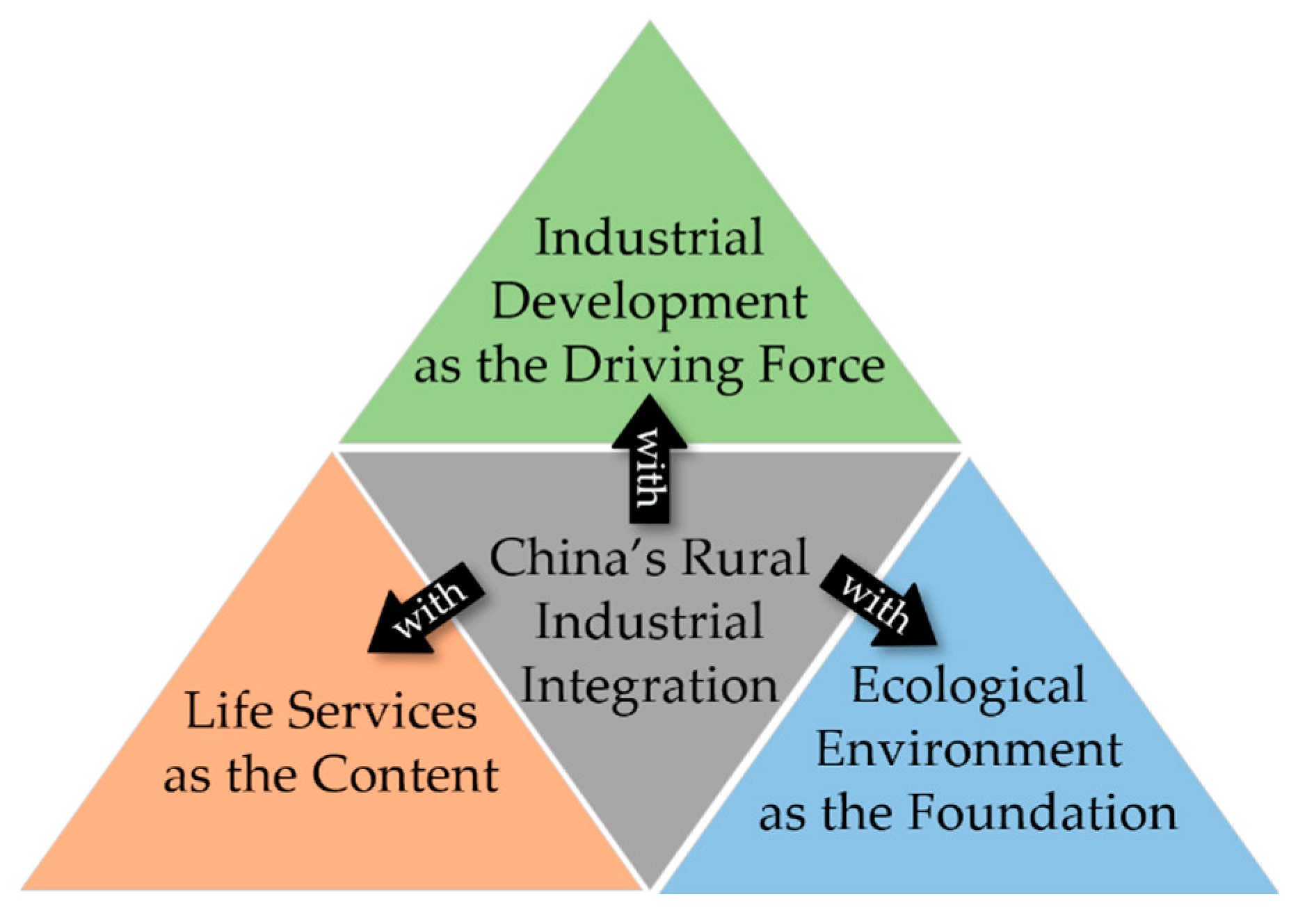
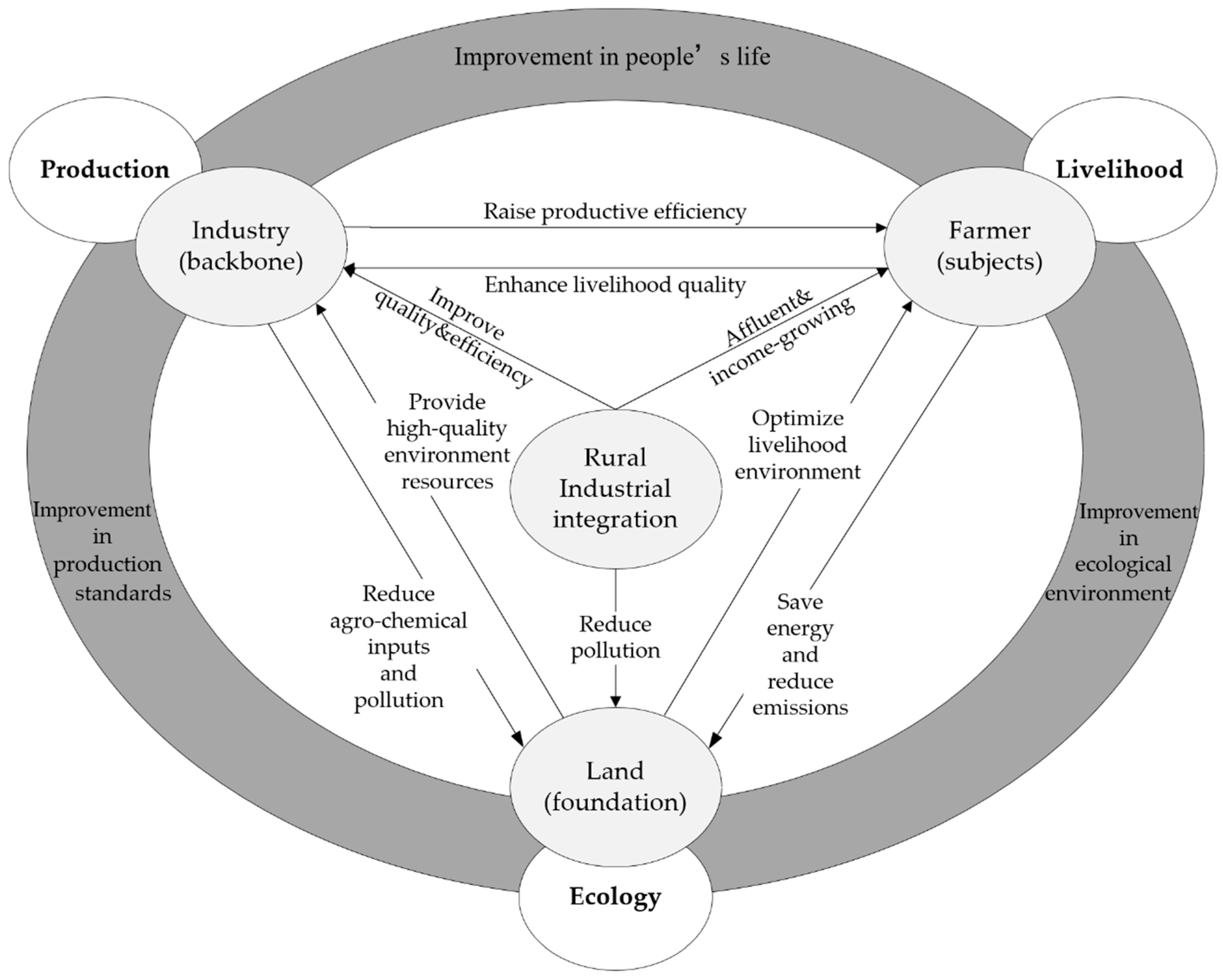

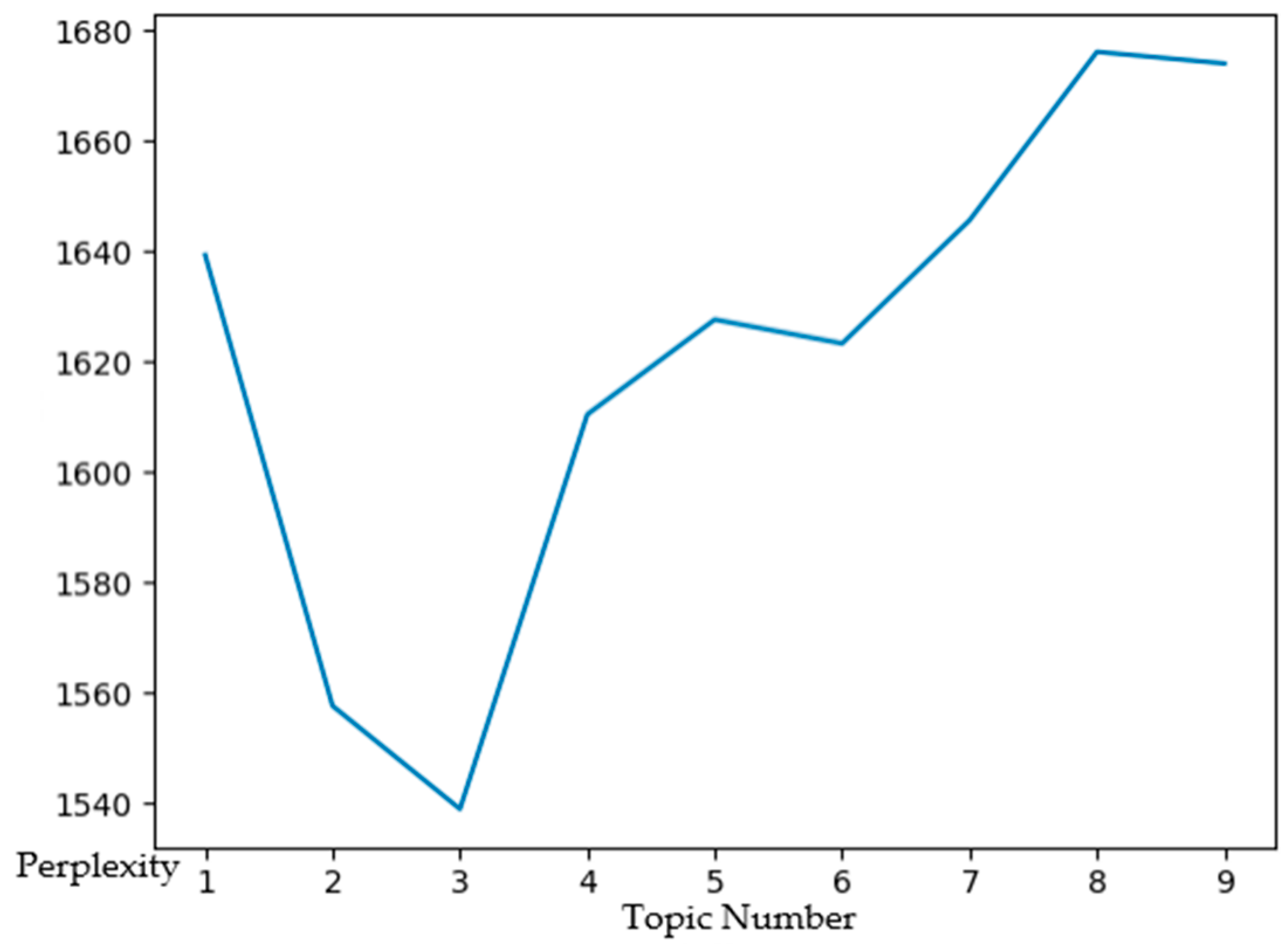
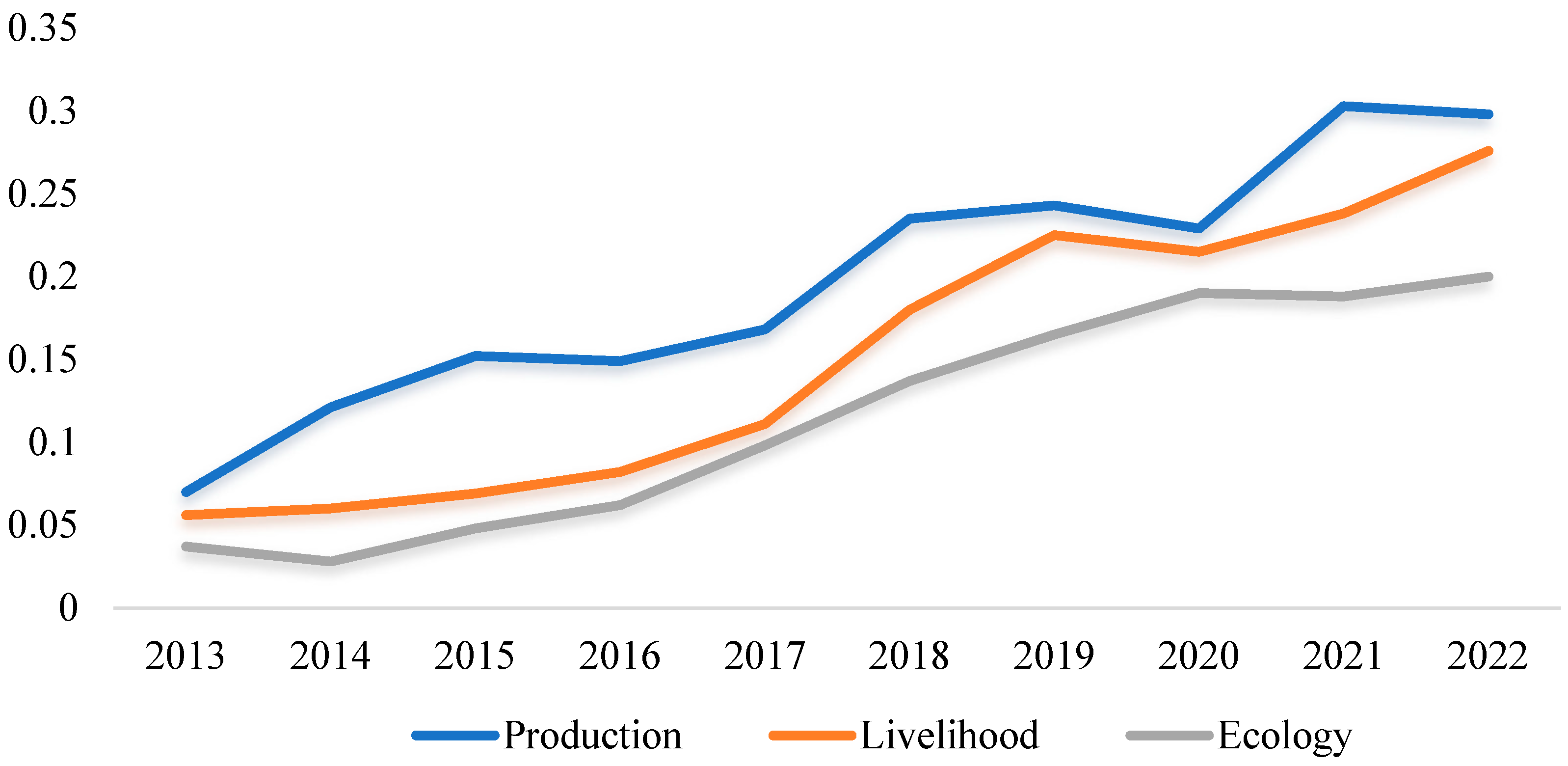


| Authors | Conceptualization |
|---|---|
| Jiang [22] | Characterization: functional transformation, chain extension, and sectoral expansion. Impetus: institutional innovation and technological convergence. Pathways: involve the penetration and cross-reorganization of crop production, agro-processing, and associated services to optimize resource allocation, facilitate factor mobility, and concentrate market demand, thereby reshaping rural industrial layouts. Outcomes: a shift in development patterns. |
| Zhao et al. [23] | Actors: farmers and diverse production–business organizations. Pathways: sector extension, high-tech penetration, and institutional innovation to achieve intensive resource allocation. Outcomes: an integrated industrial chain, transformation of farming practices, and synergistic development of the three sectors. |
| Chen et al. [24] | Foundation: rural endowments of all kinds. Modes: industrial clustering, institutional, and technological innovation. Outcomes and Objectives: progressive permeation or intersection of different sectors until they coalesce into a single integrated entity. |
| Zheng [25] | Impetus: evolving market demand and the internalization of operating costs. Modes: technological and institutional innovation. Outcomes: technical, product and market convergence across sectors, blurred industrial boundaries, and the emergence of new technologies, business formats, or models. |
| Dimension | Manifestation |
|---|---|
| Goals and Principles | Both prioritize sustainable development. |
| Means and Approaches | Both rely on comprehensive, systemic methods that emphasize multi-dimensional coordination. |
| Fields and Measures | Both require the joint participation of government, enterprises, and civil society, and their respective policy instruments are highly compatible. |
| Topic | Characteristic Words |
| Rural industrial activities | processing, tourism, entrepreneurship, leisure, modern agriculture, cooperatives, return-to-home entrepreneurs, science and technology, farms, e-commerce, online retail, finance, technicians in services, public finance, technological innovation, mechanization, agro-by-products |
| Rural living standards | infrastructure, urban–rural links, internet, poverty alleviation, urbanization, human capital, poverty eradication networks, farm household income, common prosperity, digitalization, express delivery, information technology, postal services, insurance |
| Rural ecology and environment | ecology, green, health and wellness, forests, eco-agriculture, farmhouse stays, rural tourism, green food, ecological environment, eco-tourism, environmental protection, pesticides |
| Keywords | Frequency | Keywords | Frequency |
|---|---|---|---|
| Processing | 990 | Green | 263 |
| Tourism | 960 | E-commerce | 248 |
| Entrepreneurship | 824 | Urban–rural | 247 |
| Leisure | 712 | Finance | 229 |
| Modern Agriculture | 602 | Employment | 228 |
| Cooperatives | 591 | Insurance | 225 |
| Return Migration | 499 | Service Sector | 187 |
| Science and Technology | 351 | Internet | 183 |
| Ecology | 317 | Poverty Alleviation | 145 |
| Farms | 274 | Urbanization | 136 |
| Infrastructure | 273 | Talent | 122 |
| E-commerce Platforms | 272 | Poverty Eradication | 112 |
| Primary Indicator | Secondary Indicator | Unit | Data Source |
|---|---|---|---|
| Production | GDP of the primary sector | billion CNY | China Statistical Yearbook |
| Rural employment situation | 10,000 persons | China Statistical Yearbook | |
| Per capita disposable income of rural residents | CNY | China Statistical Yearbook | |
| Central government fiscal expenditure on agriculture, forestry, and water affairs | billion CNY | China Statistical Yearbook | |
| Total power of agricultural machinery | kw | China Statistical Yearbook | |
| Agro-processing industry operating revenue | billion CNY | China Statistical Yearbook | |
| New-product projects in above-scale agro-processing enterprises | item | China Statistical Yearbook | |
| Rural retail sales | billion CNY | China Statistical Yearbook | |
| Rural household investment in services | billion CNY | China Rural Statistical Yearbook | |
| Rural household investment in accommodation and catering | billion CNY | China Rural Statistical Yearbook | |
| Rural entrepreneurship activity index | entity | China Statistical Yearbook | |
| Number of rural cooperatives | unit | China Agricultural Management Statistics Annual Report | |
| Operating revenue of leisure agriculture | billion CNY | Compiled from national ministries’ official releases | |
| Livelihood | Share of rural population | percent | China Statistical Yearbook |
| Per capita rural household consumption expenditure | CNY | China Statistical Yearbook | |
| Cultural and recreational consumption | CNY | China Statistical Yearbook | |
| Senior-secondary graduates in rural areas | person | China Statistical Yearbook | |
| Length of rural postal delivery routes | 10,000 km | China Rural Statistical Yearbook | |
| Rural broadband subscribers | 10,000 households | China Rural Statistical Yearbook | |
| Agricultural insurance coverage | percent | China Statistical Yearbook | |
| Fiscal expenditure for consolidating poverty-alleviation achievements and advancing rural revitalization | billion CNY | China Rural Statistical Yearbook | |
| Rural residents receiving minimum living allowances | 10,000 persons | China Rural Statistical Yearbook | |
| Ecology | Chemical fertilizer application | ton | China Rural Statistical Yearbook |
| Soil-erosion control area | km2 | China Rural Statistical Yearbook | |
| Water-saving irrigation area | km2 | China Rural Statistical Yearbook | |
| National afforestation area | km2 | China Statistical Yearbook | |
| Agricultural plastic film use | ton | China Rural Statistical Yearbook | |
| Pesticide use | ton | China Rural Statistical Yearbook | |
| Solar water heaters in rural areas | unit | China Statistical Yearbook |
| Primary Indicator | Secondary Indicator | Weight (%) | Attributes |
|---|---|---|---|
| Production | GDP of the primary sector | 3.821 | + |
| Rural employment situation | 3.495 | + | |
| Per capita disposable income of rural residents | 3.051 | + | |
| Central government fiscal expenditure on agriculture, forestry and water affairs | 2.428 | + | |
| Total power of agricultural machinery | 2.722 | + | |
| Agro-processing industry operating revenue | 3.927 | + | |
| New-product projects in above-scale agro-processing enterprises | 4.497 | + | |
| Rural retail sales | 2.246 | + | |
| Rural household investment in services | 1.314 | + | |
| Rural household investment in accommodation and catering | 6.345 | + | |
| Rural entrepreneurship activity index | 3.428 | + | |
| Number of rural cooperatives | 3.681 | + | |
| Operating revenue of leisure agriculture | 2.698 | + | |
| Livelihood | Share of rural population | 3.659 | + |
| Per capita rural household consumption expenditure | 3.020 | + | |
| Cultural and recreational consumption | 2.690 | + | |
| Senior-secondary graduates in rural areas | 2.950 | + | |
| Length of rural postal delivery routes | 5.380 | + | |
| Rural broadband subscribers | 3.879 | + | |
| Agricultural insurance coverage | 4.862 | + | |
| Fiscal expenditure for consolidating poverty-alleviation achievements and advancing rural revitalization | 3.741 | + | |
| Rural residents receiving minimum living allowances | 2.765 | − | |
| Ecology | Chemical fertilizer application | 5.132 | + |
| Soil-erosion control area | 3.058 | + | |
| Water-saving irrigation area | 2.251 | + | |
| National afforestation area | 2.178 | + | |
| Agricultural plastic film use | 3.868 | − | |
| Pesticide use | 5.071 | − | |
| Solar water heaters in rural areas | 1.846 | + |
| Year | Production | Livelihood | Ecology | Composite |
|---|---|---|---|---|
| 2013 | 0.070 | 0.056 | 0.037 | 0.163 |
| 2014 | 0.121 | 0.060 | 0.028 | 0.209 |
| 2015 | 0.152 | 0.069 | 0.048 | 0.270 |
| 2016 | 0.149 | 0.082 | 0.062 | 0.292 |
| 2017 | 0.168 | 0.111 | 0.098 | 0.377 |
| 2018 | 0.235 | 0.180 | 0.137 | 0.551 |
| 2019 | 0.243 | 0.225 | 0.165 | 0.633 |
| 2020 | 0.229 | 0.215 | 0.190 | 0.634 |
| 2021 | 0.303 | 0.238 | 0.188 | 0.729 |
| 2022 | 0.298 | 0.276 | 0.200 | 0.773 |
| Year | Rural Household Investment in Accommodation and Catering | Agricultural Insurance Coverage | Total Power of Agricultural Machinery | Per Capita Disposable Income of Rural Residents | Length of Rural Postal Delivery Routes | Chemical Fertilizer Application | Pesticide Use | GDP of the Primary Sector | New-Product Projects in Above-Scale Agro-Processing Enterprises |
|---|---|---|---|---|---|---|---|---|---|
| 2023 | 46.99 | 1380.47 | 113,881.84 | 22,357.33 | 4,361,507.00 | 5006.95 | 117.35 | 92,428.55 | 24,781.85 |
| 2024 | 60.91 | 1487.52 | 117,402.22 | 24,403.99 | 4,431,124.50 | 4945.33 | 116.11 | 95,720.13 | 26,502.47 |
| 2025 | 55.11 | 1591.00 | 121,218.33 | 26,165.44 | 4,470,643.50 | 4761.49 | 112.98 | 99,226.30 | 27,953.23 |
| 2026 | 64.87 | 1700.82 | 123,711.94 | 27,392.53 | 4,544,310.50 | 4554.15 | 108.13 | 103,428.80 | 28,689.12 |
| 2027 | 72.14 | 1756.24 | 126,620.30 | 28,622.05 | 4,581,201.00 | 4405.70 | 104.38 | 107,253.43 | 29,994.22 |
| 2028 | 77.75 | 1799.29 | 131,012.70 | 29,384.69 | 4,633,576.50 | 4270.84 | 101.59 | 109,949.09 | 32,284.23 |
| 2029 | 83.12 | 1834.56 | 136,316.98 | 30,162.72 | 4,748,604.00 | 4114.35 | 101.00 | 113,207.81 | 34,017.94 |
| 2030 | 88.33 | 1855.83 | 140,079.16 | 32,120.08 | 4,818,017.50 | 3967.10 | 98.32 | 116,709.60 | 34,796.79 |
Disclaimer/Publisher’s Note: The statements, opinions and data contained in all publications are solely those of the individual author(s) and contributor(s) and not of MDPI and/or the editor(s). MDPI and/or the editor(s) disclaim responsibility for any injury to people or property resulting from any ideas, methods, instructions or products referred to in the content. |
© 2025 by the authors. Licensee MDPI, Basel, Switzerland. This article is an open access article distributed under the terms and conditions of the Creative Commons Attribution (CC BY) license (https://creativecommons.org/licenses/by/4.0/).
Share and Cite
Zhang, J.; Ma, M.; Qian, J.; Ma, L. China’s Rural Industrial Integration Under the “Triple Synergy of Production, Livelihood and Ecology” Philosophy: Internal Mechanisms, Level Measurement, and Sustainable Development Paths. Sustainability 2025, 17, 8972. https://doi.org/10.3390/su17208972
Zhang J, Ma M, Qian J, Ma L. China’s Rural Industrial Integration Under the “Triple Synergy of Production, Livelihood and Ecology” Philosophy: Internal Mechanisms, Level Measurement, and Sustainable Development Paths. Sustainability. 2025; 17(20):8972. https://doi.org/10.3390/su17208972
Chicago/Turabian StyleZhang, Jinsong, Mengru Ma, Jinglin Qian, and Linmao Ma. 2025. "China’s Rural Industrial Integration Under the “Triple Synergy of Production, Livelihood and Ecology” Philosophy: Internal Mechanisms, Level Measurement, and Sustainable Development Paths" Sustainability 17, no. 20: 8972. https://doi.org/10.3390/su17208972
APA StyleZhang, J., Ma, M., Qian, J., & Ma, L. (2025). China’s Rural Industrial Integration Under the “Triple Synergy of Production, Livelihood and Ecology” Philosophy: Internal Mechanisms, Level Measurement, and Sustainable Development Paths. Sustainability, 17(20), 8972. https://doi.org/10.3390/su17208972





